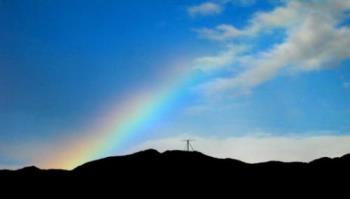rainbow
By shilpa28k
@shilpa28k (1737)
India
December 15, 2006 4:29am CST
How is rainbow formed? why is it in such a shape?
A rainbow is an optical and meteorological phenomenon that causes a nearly continuous spectrum of light to appear in the sky when the Sun shines onto droplets of moisture in the Earth's atmosphere. It takes the form of a multicoloured arc, with red on the outside and violet on the inside. A double rainbow includes a second, fainter, arc with colors in the opposite order, that is, with violet on the outside and red on the inside.
Even though a rainbow spans a continuous spectrum of colours, traditionally the full sequence of colours is most commonly cited as red, orange, yellow, green, blue, indigo and violet. It is commonly thought that indigo was included due to the different religious connotations of the numbers six and seven at the time of Isaac Newton's work on light, despite its lack of scientific significance and the poor ability of humans to distinguish colours in the blue portion of the visual spectrum.
The rainbow effect can be observed whenever there are water drops in the air and sunlight shining from behind the observer at a low altitude or angle. The most spectacular rainbow displays when half of the sky is still dark with draining clouds and the observer is at a spot with clear sky overhead. The rainbow effect is also commonly seen near waterfalls or fountains. Rainbow fringes can sometimes be seen at the edges of backlit clouds and as vertical bands in distant rain or virga. The effect can also be artificially created by dispersing water droplets into the air during a sunny day.
In a very few cases, a moonbow, or night-time rainbow, can be seen on strongly moonlit nights. As human visual perception for colour in low light is poor, moonbows are most often perceived to be white.
Rainbows may also appear in the spray of a water fountain. The rainbow's appearance is caused by dispersion of sunlight as it is refracted by (approximately spherical) raindrops. The light is first refracted as it enters the surface of the raindrop, reflected off the back of the drop, and again refracted as it leaves the drop. The overall effect is that the incoming light is reflected back over a wide range of angles, with the most intense light at an angle of about 40°– 42°. This angle is independent of the size of the drop, but does depend on its refractive index. As seawater has a higher refractive index than rain water, the radius of a 'rain'bow in a sea spray is smaller than a true rainbow. This is visible to the naked eye by a misalignment of these bows.
Since the water is dispersive, the amount that the sunlight is bent depends upon the wavelength, and hence colour, of the light's constituent parts. Blue light is refracted at a greater angle than red light, but because the area of the back of the droplet has a focal point inside the droplet, the spectrum crosses itself, and therefore the red light appears higher in the sky, and forms the outer colour of the rainbow. Contrary to popular belief, the light at the back of the raindrop does not undergo total internal reflection; however, light that emerges from the back of the raindrop does not create a rainbow between the observer and the Sun. The spectra emitted from the back of the raindrop do not have a maximum of intensity, as the other visible rainbows do, and thus the colours blend together and do not form a rainbow.
1 person likes this
1 response
@september_1st (3209)
• Romania
15 Dec 06
Well... you answered your own qestion.
However, i do not search for scientific explanation on rainbows, i just fully enjoy when i see one :)






